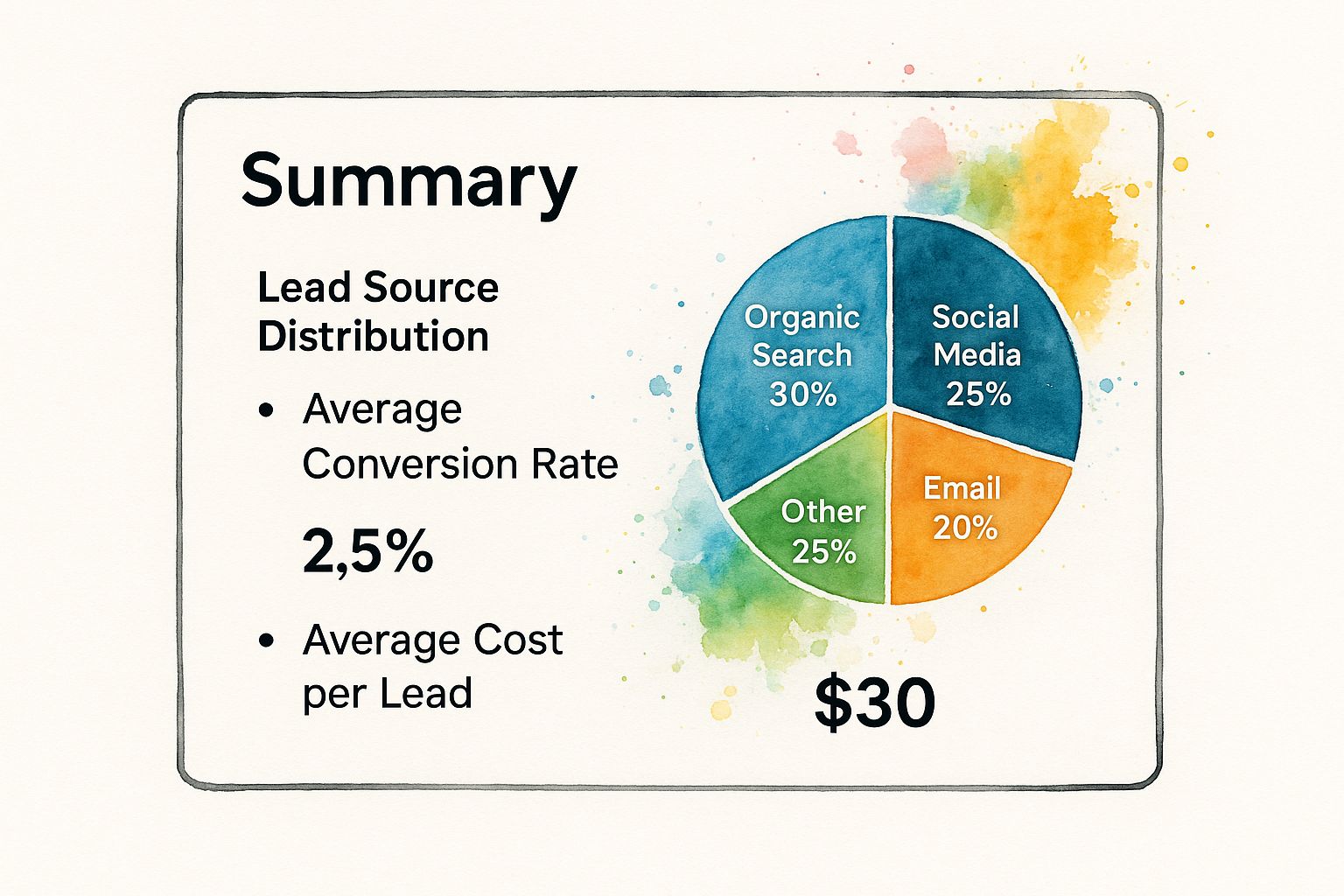Generating leads online isn't just about casting the widest net possible. It’s about a multi-channel approach that prioritizes quality over quantity. This means creating content people actually want, making sure they can find it with SEO, engaging on social media, and using smart paid ads to pull in prospects who are a perfect fit for what you offer.
Moving Beyond Clicks to High-Quality Leads
Let's get real for a second: not all leads are created equal. The old playbook of just chasing clicks and stockpiling email addresses is getting more expensive and less effective by the day. Real, sustainable growth comes from attracting high-quality leads—people who aren't just window shopping but are actively looking for the exact solutions you provide.
Forget the outdated tactics. We're going to focus on a modern, integrated strategy that builds a reliable system for bringing your ideal customers to you.
Understanding the Modern Challenge
Lead generation is still a top priority for 50% of marketers, but the game has changed. While companies pull in an average of 1,877 leads per month, the cost can shoot up to $198.44 per lead. At the same time, old-school interruptive methods are dead in the water—a staggering 97% of people now ignore cold calls.
The goal isn't just to generate a lead anymore. It's to start a conversation with the right person. A quality lead is someone who has a problem you can solve and has shown real interest in your ability to solve it.
This breakdown shows where leads typically come from and what good performance looks like.

As you can see, a healthy mix of channels is crucial, but organic search consistently proves to be a powerful engine for bringing in new leads.
The Pillars of Quality Lead Generation
A successful strategy really stands on four core pillars. Each one plays a distinct part in attracting and converting the people you want to reach.
- Content Marketing: This is your foundation. When you create truly valuable, problem-solving content, you naturally attract an audience and build trust. You can see some great examples in action over on the RebelGrowth blog.
- Targeted SEO: This is how you make sure your content gets discovered by people who are typing their problems into Google. It’s all about connecting your expertise directly to what users are searching for.
- Strategic Social Media: This is where you build your community and engage with prospects where they already are, whether it's building B2B relationships on LinkedIn or showcasing a brand on Instagram.
- Smart Paid Advertising: This gives your best efforts a turbo boost. Paid ads let you target specific demographics and behaviors with incredible precision, accelerating your lead flow when you need it.
For a deeper dive into how these elements work together, it's worth exploring proven small business lead generation strategies that can make a huge difference in customer acquisition. This guide will walk you through how to put each of these pillars into practice.
Before we dive into the nitty-gritty of each strategy, here’s a quick overview of how these channels stack up in the modern lead generation landscape.
Modern Lead Generation Channels at a Glance
| Channel | Primary Goal | Best For |
|---|---|---|
| Content Marketing | Build trust & authority | Attracting organic traffic through value-driven information |
| SEO | Increase visibility | Capturing prospects with high purchase intent from search engines |
| Social Media | Build community & engagement | Nurturing relationships and building brand awareness |
| Paid Advertising | Drive targeted, immediate traffic | Reaching specific audience segments quickly and scaling results |
Each channel has its place, and the most successful companies find the right blend that works for their specific audience and goals. Now, let’s get into the how-to for each one.
Building Your Organic Lead Generation Engine

Forget about chasing short-term wins. A truly effective online lead generation strategy is about building a sustainable system—an engine that attracts qualified prospects around the clock, working for you even when you’re not.
This is where the powerhouse combo of content marketing and search engine optimization (SEO) comes in. They work together to create an engine that pulls in the right people, consistently. The idea is simple: create genuinely valuable, problem-solving content that your ideal customers are already looking for.
When you consistently publish material that speaks directly to their pain points, you’re not just making noise. You’re building authority, earning trust, and naturally drawing people into your world.
And it's not just a nice idea—it's brutally effective. Content marketing is known to generate leads at a rate three times higher than old-school outbound methods. It's no wonder that 72% of companies say content has directly boosted their lead numbers. To see those kinds of results, you need a solid game plan. You can find more details in these lead generation statistics and trends.
Crafting Content That Actually Attracts Leads
First things first: you need to get inside your customer's head. What keeps them up at night? What questions are they typing into Google? Those are your content topics. Forget about churning out generic blog posts and start thinking about creating the most useful resources on the internet for those specific problems.
For example, a software company could create a massive guide on "How to Choose the Right Project Management Tool." A local accounting firm? They might publish a detailed case study showing exactly how they helped a small business crush tax season. These pieces attract high-intent traffic because they offer real-world solutions, not just fluff.
Key Takeaway: Your goal isn't just to write about a topic. It's to create the single best answer on the internet for your customer's most pressing questions. That's how you win in search and attract people who are ready to listen.
Once you have their attention, you need a clear way for them to raise their hand and say, "I'm interested." That's where lead magnets come into play.
Using Lead Magnets to Convert Readers into Leads
A lead magnet is a valuable, free resource you offer in exchange for a visitor's contact information. Think of it as the bridge that takes someone from being a casual reader to a potential customer.
Some of the most effective lead magnets I've seen include: * Checklists or Worksheets: A simple, downloadable checklist summarizing the steps in your guide. * Ebooks or Whitepapers: A deeper dive into a complex topic that your blog post only scratched the surface of. * Case Studies: A detailed breakdown of how you got incredible results for a client, which is the ultimate proof of your value. * Templates: A ready-to-use spreadsheet or document that saves your audience a ton of time and effort.
Let's say you just wrote an in-depth guide on social media scheduling. At the end, you could offer a free "Social Media Content Calendar Template." This provides immediate, tangible value and captures the contact info of someone who is clearly interested in what you do. With RebelGrowth, you can even use our AI to scan your content and suggest the most compelling lead magnet ideas based on what your audience is reading.
Optimizing Your Content so People Can Find It
Creating killer content is only half the battle. If nobody can find it, it doesn't matter how good it is. This is where SEO comes in. Optimizing your content is what gets you on the first page of Google when your ideal customers are searching for answers.
Focus on these core on-page SEO elements: 1. Keyword Integration: Weave your target keyword (like "how to generate leads online") naturally into your title, headings, and throughout the body of your content. Don't force it. 2. Meta Descriptions: Write a compelling meta description. This is your 160-character ad on the search results page—make it count and earn that click. 3. Internal Linking: Link to other relevant posts on your site. This keeps people on your site longer and helps spread link authority around. 4. Image Optimization: Use descriptive alt text for all your images. It helps with accessibility and gives search engines more context about your page.
Building a true organic lead generation engine is a long-term play, but the payoff is huge. By consistently creating and optimizing high-value content, you build a reliable, predictable flow of high-quality leads that will fuel your business for years to come.
Turning Social Media into a Lead Machine

So many businesses treat social media like a popularity contest. They chase likes, comments, and follows, but those numbers rarely translate into actual revenue. It's time to stop obsessing over vanity metrics and start building a direct pipeline from these platforms to qualified prospects.
The whole game is about choosing the right playground and playing by its rules.
Mastering LinkedIn for B2B Lead Generation
For most B2B companies, that playground is LinkedIn. It's less of a social network and more of a professional powerhouse where you can connect directly with decision-makers. A generic company page just broadcasting updates won't cut it, though. You need to be deliberate.
Your strategy starts with your personal profile, not your company page. People connect with people, not faceless logos. You need to optimize your headline and summary to speak directly to your ideal customer’s pain points and how you, personally, solve them.
Think of your profile as a mini-landing page. Instead of a boring job title, try something like, "Helping SaaS Founders Scale with Predictable Lead Flow." This immediately signals who you help and attracts the right kind of connection requests.
Once your profile is dialed in, your content strategy needs to be a one-two punch:
- Share High-Value Content: Post insightful articles, case studies, and unique industry analysis that prove you know your stuff. Don't just dump links to your blog, either. Write thoughtful, native text posts that deliver value right there in the LinkedIn feed.
- Engage Meaningfully: Don't just post and ghost. Join relevant industry groups, drop thoughtful comments on other people’s posts, and actually participate in conversations. This builds real visibility and positions you as a helpful expert, not just another vendor.
LinkedIn has become an absolute titan for online lead generation in the B2B world. A staggering 40% of B2B marketers now say it's their most effective channel for high-quality leads. This is fueled by massive organic engagement, with 40% of visitors interacting with business pages every single week.
LinkedIn’s own tools are also incredibly powerful. Their Lead Gen Forms, which pre-fill a user’s profile information, are a game-changer. These things boast an average conversion rate of 13%—that's more than five times higher than a typical website landing page. You can dig into more of these powerful LinkedIn lead generation statistics if you're curious.
B2C Strategies for Visual Platforms like Instagram
For B2C brands, the playbook is completely different. The focus shifts from professional credibility to visual storytelling and community building. This is where platforms like Instagram shine. Your goal is to create an aspirational and relatable brand identity that people want to be a part of.
Your content needs to be built around high-quality visuals that tell a story about your product and the lifestyle that comes with it. User-generated content is pure gold here, as it acts as authentic social proof. Encourage your customers to share photos with your product by creating a simple, branded hashtag.
Community engagement is just as critical. Reply to comments, run polls in your stories, and use features like Instagram Live to connect with your audience in real-time. To turn that engagement into leads, you can lean on:
- "Link in Bio" tools to create a simple hub that directs traffic to specific landing pages or product collections.
- Story stickers like quizzes and Q&As to spark one-on-one conversations in the DMs.
- Instagram Shopping features to make the path from seeing a product to buying it completely seamless.
By picking the right platform and tailoring your strategy to its unique culture, you can finally transform your social media presence from a passive billboard into an active, high-performing lead generation machine.
Accelerating Lead Flow with Paid Advertising

While organic strategies like SEO and content marketing build a powerful, long-term foundation, sometimes you just need to turn on the faucet. Paid advertising is that faucet. It’s a potent amplifier, letting you pour fuel on the fire to drive immediate, targeted traffic exactly where you want it.
Think of it as your direct line to a hand-picked audience. Instead of waiting for them to find you, you go right to their digital doorstep. This is perfect for testing a new offer, pushing a time-sensitive campaign, or simply scaling up what’s already working organically. It’s all about getting the right message in front of the right person at the exact right moment.
Targeting High-Intent Users with Google Ads
When someone types a problem into Google, they aren’t just browsing—they're actively looking for a solution. Right now. This makes Google Ads an incredibly powerful channel for grabbing high-intent leads.
The key is knowing where to start. There are two main types of campaigns:
- Search Campaigns: These are the text ads you see at the top of Google's search results. You bid on specific keywords, like "project management software for small teams." You're showing up as a direct answer to a user's stated problem, which means the leads you get are often highly qualified.
- Display Campaigns: These are the visual ads that follow you around the internet, appearing on websites, apps, and videos. While they’re less targeted by immediate intent, they are fantastic for building brand awareness and retargeting people who’ve already visited your site.
For generating quality leads online, starting with a focused search campaign is almost always the best move. You're meeting customers at their precise moment of need. For those looking to dive deeper, this excellent guide to PPC campaign optimization offers some serious insights into refining your approach.
Precision Targeting with Social Media Ads
Social media platforms offer a completely different, but just as powerful, advantage: a massive trove of demographic and psychographic data. You can target people based on their job titles, interests, online behaviors, and much more.
One of the most effective tactics here is building lookalike audiences.
This is where you upload a list of your existing customers or best leads. The platform’s algorithm then analyzes their shared characteristics and builds a new, much larger audience of users who "look like" them. It’s a remarkably effective way to find new, qualified prospects with incredible precision.
Key Takeaway: Paid advertising isn't a replacement for organic marketing; it's a powerful partner. Use organic to build trust and authority, and use paid ads to amplify your reach and accelerate results with laser-focused targeting.
Of course, your ad copy and landing page are critical. The ad needs to grab attention and make a clear promise. The landing page must then deliver on that promise with a compelling offer and a simple, frictionless form. Always A/B test your headlines, images, and calls-to-action to continuously push your cost-per-lead down.
With the right tools, you can manage these complex campaigns and even get AI-powered suggestions to boost performance. You can explore how RebelGrowth’s AI features can help streamline this entire process by starting a free trial today.
Turning Your Website Traffic Into Leads
Getting traffic to your site is a huge win, but it’s only half the battle. The real magic happens when you turn those anonymous visitors into actual, identifiable leads. We call this process Conversion Rate Optimization (CRO), and it’s usually less about massive, expensive redesigns and more about making smart, focused improvements.
It all starts with your landing page. This is a specific page built for a single purpose: to convince a visitor to take one particular action. A great landing page isn't just some random page on your website; it's a finely tuned experience. It needs a magnetic headline that grabs a visitor by the collar and speaks directly to their problem, plus a crystal-clear value proposition that answers their unspoken question, "What's in it for me?"
For example, instead of a vague headline like "Our Services," you could try something far more specific and compelling, like "Get a Custom Marketing Plan in 48 Hours." See the difference? The second one instantly communicates a clear benefit and a concrete timeframe. That’s what gets clicks.
Designing Pages That Actually Convert
Your landing page has to be a masterclass in both persuasion and simplicity. Every single element, from the headline to the button, should guide the visitor toward your conversion goal without any friction. This is exactly where a lot of businesses stumble, cluttering their pages with confusing options and distracting links.
Here’s a quick rundown of what every high-converting page needs:
- Compelling Social Proof: You need to show that other people have already found success with you. This means testimonials, in-depth case studies, or even just logos of well-known clients. It’s all about building trust.
- Frictionless Forms: I can't stress this enough: keep your forms as short as humanly possible. Only ask for the information you absolutely need. Every extra field you add is another reason for someone to give up and leave.
- A Single, Clear Call-to-Action (CTA): Don't overwhelm your visitors with choices. Give them one primary button with action-oriented text. Think "Download Your Free Guide" or "Start My Trial," not a lazy "Submit."
Your landing page has one job—to convert. You need to ruthlessly remove every link, button, and distraction that doesn't directly support that one goal. For pages tied to ad campaigns, this absolutely means getting rid of your main website navigation.
We've put together a more detailed guide on what makes for truly effective, high-converting landing pages that drive action, complete with examples and templates you can use.
The Power of Testing and Understanding Your Visitors
Here's the good news: you don't have to guess what works. Simple A/B testing—where you create two versions of a page to see which one performs better—can produce incredible results. Just be sure to test one element at a time, like your headline, CTA button color, or the main image. I’ve seen tiny tweaks lead to massive lifts in conversion rates.
Once you've got visitors flowing in, especially from paid ads, the next critical step is to accurately measure their journey to becoming a lead. This is where you need to know how to implement robust Google Ads conversion tracking. It’s the only way to connect your ad spend directly to real business outcomes and ensure every dollar is accounted for.
Tools like heatmaps are also invaluable here. They visually show you exactly where people are clicking, how far they're scrolling, and where they're getting stuck. This data gives you the "why" behind your numbers, helping you pinpoint and fix the roadblocks that are killing your conversions. It's a non-negotiable piece of the puzzle for anyone serious about generating leads online.
Answering Your Top Lead Generation Questions
As you start putting these strategies into practice, you're bound to run into some real-world questions. It happens to everyone. So, I've put together answers to the most common queries I hear from marketers and business owners trying to generate leads online.
Think of this as your go-to guide for clearing those common hurdles and making smarter calls as you build out your lead generation engine.
How Much Should I Budget for Lead Generation?
This is the million-dollar question, isn't it? But saying "it depends" isn't very helpful. While there's no magic number, the key is to stop thinking of it as a cost and start seeing it as an investment tied directly to your goals. Your industry, target cost-per-lead (CPL), and the channels you pick will all play a huge role.
Instead of just guessing, here’s a much better way to approach it:
- Start by setting aside a small, manageable test budget for one or two channels that look promising. This could be a specific Google Ads search campaign or a set of ads on LinkedIn.
- Then, get obsessive about optimizing those campaigns for conversions, not just clicks or impressions. That’s what really matters.
- Once a channel proves it can bring in leads at a CPL you're happy with, you can confidently start scaling up your investment.
This data-first approach takes the guesswork out of the equation. You'll know you're putting your money where it will actually work for your business.
Which Lead Generation Channel Is the Best?
There’s no single "best" channel. I know that's not what you want to hear, but it's the truth. The best channel is simply where your ideal customers hang out and are most open to hearing from you. Trying to be everywhere at once is a classic recipe for burning through your budget with almost nothing to show for it.
Key Insight: Don't chase shiny new trends. Go where your customers already are. Your job isn't to be a master of every single platform; it's to master the one or two that actually move the needle for your audience.
For instance, a B2B company selling a high-ticket service will almost always find its best leads through SEO-driven content and highly targeted outreach on LinkedIn. On the other hand, a B2C brand with a very visual product might crush it with Instagram Shopping and TikTok video ads. The trick is to test, measure everything, and then double down on what brings in quality leads.
How Long Until I See Results from SEO?
This is where you need to practice some serious patience. SEO and content marketing are long-term plays. You’re not just renting attention; you're building a valuable, sustainable asset for your business.
You might see some small bumps in traffic within a few months, which is encouraging. But it generally takes a solid 6-12 months of consistent, high-quality work to see those significant, compounding results that really change the game.
Paid ads can get you traffic almost instantly, but that fire goes out the second you stop feeding it money. A smart, healthy strategy uses both. Use paid ads for quick wins and hyper-targeted campaigns while your SEO efforts are quietly building a powerful, organic lead-generation machine that will pay dividends for years.
Ready to stop guessing and start growing? RebelGrowth combines powerful AI tools with a proven marketing framework to help you generate more high-quality leads. Build your content engine, launch targeted campaigns, and turn your website traffic into real revenue. Explore how RebelGrowth can transform your marketing today.
